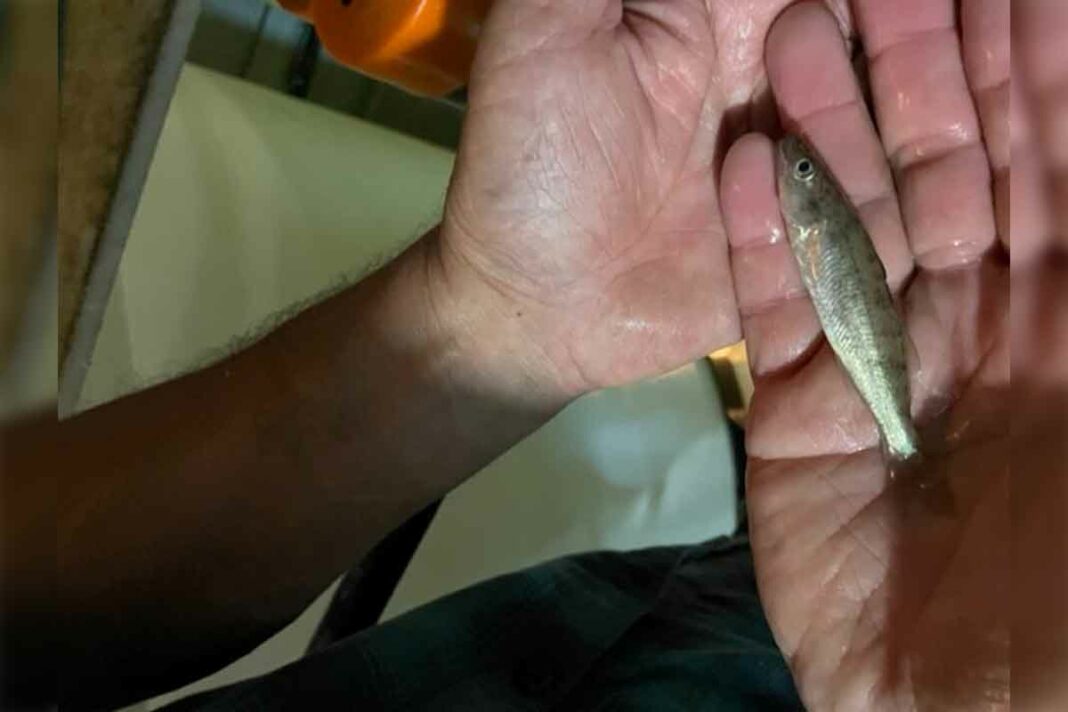LAKE MANITOU—The Lake Manitoulin Area Association (LMAA) is pleased that in working together with the Ministry of Natural Resources (MNR) that the ministry will be stocking walleye yearlings on an experimental basis in Lake Manitou for the next 10 years.
“From where we started, we are pleased with the plan that the MNR has come up with,” said Mike Costigan, chair of and member of the LMAA fishery committee. “We have met as a group three or four times with ministry representatives Denis Gendron (MNR district management biologist), Derrick Luetchford, written letters and have had discussions with their hatchery people as well on this issue.”
“The MNR will undertake restoration stocking efforts on an experimental basis over the next 5-10 years, while continuously monitoring walleye numbers,” said Mike Fenn, communications services branch with MNR. “These steps will help MNR analyze how well management actions are working and help the walleye population become self-sustaining over time.”
Mr. Fenn said, “while every lake is unique and fish stocking doesn’t always resolve population issues, it can help in some situations. It’s important for the MNR and the LMAA to work closely together for this plan to succeed.”
Mr. Gendron told The Expositor that because of declining walleye populations the MNR has been looking at options, one of the reasons the plan was developed.
“In a nutshell, what the MNR came up with is a 10-year restocking plan for walleye in Lake Manitou,” said Mike Costigan. “This year, the MNR will be stocking 2,500 walleye yearlings into Lake Manitou, to be conducted in the next week or so. And the ministry is aiming, in each of the next four years, to stock 4,000-4,500 walleye yearlings in Lake Manitou.”
“One of the reasons they are going to stock walleye yearlings is that they have the best chance for survival,” said Mr. Costigan. “From our (LMAA) perspective, the plan is conservative, but the ministry is taking into account that Lake Manitou has a diverse fish species, and they don’t want to hamper or threaten other fish species like lake trout or bass. The ministry doesn’t want to threaten the diverse species of fish that are currently in the lake.”
“Denis also had Kim Crawford in the discussions, a regional fisheries specialist with the MNR who has worked extensively with Lake Nipissing Walleye and brook trout,” said Mr. Costigan. “They’ve been stocking yearlings there and have had real success with the stocking program.”
The walleye yearlings being stocked will have their fins clipped to identify that they are stocked fish, said Mr. Costigan.
Mr. Costigan explained after the fifth year of the plan, it will be evaluated to see how successful it has been.
“And between now and 2030 the ministry will be carrying out more broad scale monitoring on walleye in the lake,” said Mr. Costigan. “They (MNR) are also hoping to reduce the number of walleye eggs that the ministry currently takes out of Lake Manitou. They are hoping to use them in Silver Lake (on Manitoulin),” he said.
“After the first five years, the plan will be reviewed, but the MNR will continue to annually stock 4,000-4,500 yearlings in Lake Manitou,” said Mr. Costigan. Between 2030-2035, they may revise their plan after reviewing the broad scale monitoring; what anglers are catching in the lake and egg collection.
Mr. Costigan said after the LMAA annual general meeting in July the group established its fishery committee, with their first meeting with the MNR held September 6, and the second meeting held December 11. “As a result, after our December meeting they (MNR) made an initial offer which sounded more like a one-time effort to stock walleye in Lake Manitou. We indicated our association’s goal was to have a longer, 10-year plan and commitment. We are trying to restore the walleye population, without turning it into a walleye lake.”
“Lake Manitou is known as a lake trout lake,” continued Mr. Costigan, noting the MNR stocks many lakes with a strain of lake trout (spawn) that it can only get out of Lake Manitou. “There has been a debate for a long time that walleye was a native species to Lake Manitou. LMAA member Peter Hutchinson did research on this and discovered that there was a walleye fishery in the early 1900s. We presented this to Denis (Gendron) and Derrick (Luetchford) in one of the meetings we had with them. He explained there was a rumour that in the 1990s there was an accidental release of about 30-50 walleye fingerlings in the lake. The long and short of it is that walleye have been in the lake for at least 30-35 years.” He pointed out the MNR used to do fall index netting and for about 20 years the MNR has netted walleye and for those 20 years the ministry has taken millions of walleye eggs annually out of Lake Manitou and raised them at the Blue Jay Creek Fish Culture Station to stock in Silver Lake and Kagawong Lake and others lakes off-Island.
“There is data that there was a local walleye population in the 2000s, but as ministry broad scale netting in Manitou since 2011 has shown, there has been a consistent decline in the walleye population,” continued Mr. Costigan. “This was our major beef, that the ministry had taken 100 million walleye eggs out of Lake Manitou over the years and never put any of the fish back in to the lake, and this was a reason for a decline in their population.”
Mr. Costigan said the LMAA did its own research into all of this, contacting Seija Deschenes of Manitoulin Streams Improvement Association for contacts of people having historical data in regards to walleye and potential walleye population capacity for the lake, and also contacted Bob Florean and George Morgan. “Seija had previously worked for Mr. Morgan, who is a very respected aquatic ecologist and probably the most knowledgeable person around on the issue. We sent him a letter with some questions and he had a lot of data on hand. He reached out to the ministry and held some meetings as well to present our questions. I’m sure his influence played a role in the plan the ministry put together.”
After several meetings of LMAA and MNR, “In mid-March, Denis (Gendron) reached out to me and said they (MNR) had a plan in place,” said Mr. Costigan. “We met on March 27 virtually and he presented the plan to us. As a committee we feel the plan that has been outlined is a positive for Lake Manitou. We are very pleased with it.”
“The other positive thing that came out of all of this is that it has opened the dialogue with the ministry on Lake Manitou fishing and the fishery,” said Mr. Costigan. “Going forward, they said they will continue to include us in consultation and dialogue on any other issues around Manitou. All the meetings we have had with the ministry have been very positive, and we have a very good relationship with the ministry.”
Mr. Costigan felt that an MNR announcement last December that it is constructing a new building for raising walleye at the Blue Jay creek Fish Culture Station in Tehkummah, to increase the production of walleye by as much as 600 percent annually to meet the ministry’s current stocking plans, played a role in this new stocking plan as well.




